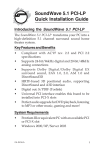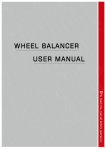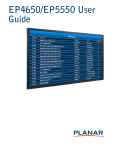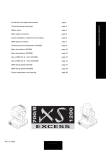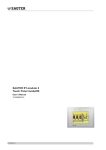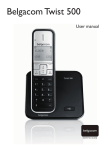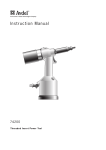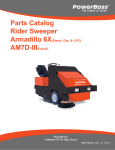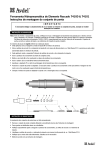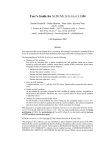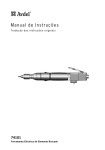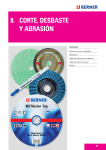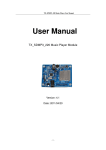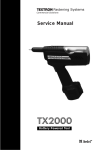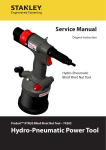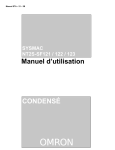Download Jewel (Tech) - RJ Mobility
Transcript
RJ MOBILITY LTD. JEWEL INDOOR POWERCHAIR TECHNICAL MANUAL THE PROVEN RELIABLE INDOOR POWERCHAIR This Technical Manual will ensure that the wheelchair is maintained to the required standard and is for use by trained personnel only. This Technical Manual contains important information regarding maintenance of the Jewel Powerchair thus ensuring its safe operation. Please make sure that you understand all instructions thoroughly. It is recommended that maintenance is undertaken at six monthly intervals for a wheelchair that is in constant daily use. The safety of the wheelchair user is paramount. If there is any doubt as to the suitability of re-using existing parts they should be discarded and replaced with manufacturer approved parts. User Manuals should be stamped at correct intervals following completion of maintenance work. If you fail to understand anything or have any questions concerning maintenance and operating instructions please contact: RJ MOBILITY LTD. Boy Lane, Wheatley Halifax HX3 5AF England Tel: +44(0) 1422 358888 Fax: +44(0) 1422 355924 -1- CONTENTS Section 1 2 3 4 5 6 7 8 9 10 11 12 13 14 15 16 17 18 19 USER CATEGORIES SPECIFICATIONS POWERCHAIR DIAGRAM MAINTENANCE CHECKS TOOL REQUIREMENTS UPHOLSTERY ARMRESTS FOOTRESTS BRAKES BACKRESTS FRAME, LOCKING LINKS AND CROSSBRACES CASTORS POWER DRIVE SYSTEM ELECTRICAL SYSTEM PROGRAMMABLE CONTROLLER ELEVATING LEGREST ARMREST OUTRIGGERS DETACHABLE TRAY KERB CLIMBER -2- JEWELTECHA. SECTION 1. USER CATEGORIES A2 Attendant Controlled. Degree of upper body control to maintain sitting position. A4 Occupant capable of using one hand to control the powerchair having spatial awareness, co-ordinated motor skills and sufficient manual dexterity to operate the controller. The occupant should also have enough upper body control to maintain a sitting position. A5 Chin Controlled. Degree of upper body control to maintain sitting position. Capable of using chin movements to control powerchair. Co-ordinated motor skills. IMPORTANT The above identifies the minimum user characteristics suitable for the Jewel foldaway powerchair. -3- SECTION 2. SPECIFICATIONS (Dimensions based on seat size 43cm x 43cm (17inch x 17inch) 1. 2. 3. 4. 5. 6. 7. 8. 9. Overall length Overall width Folded length Folded width Folded height Maximum weight Heaviest Component Seat plane angle *Seat depths available 10. *Seat widths available 11. 12. 13. 14. 15. 16. 17. 18. 19. 20. 21. 22. 23. 24. 25. 26. * ** Seat height at front Backrest angle Backrest height Footrest to seat Leg to seat angle Armrest to seat Front armrest to backrest Drive wheel diameter Tyre Pressures Maximum load capacity Turning Space (a) Spin turn (b) Between walls Range ** (30 Amp/hr Battery) Static Stability (a) Front (b) Rear (c) Side Maximum forward speed Maximum stopping distance Dynamic stability uphill 89cm (35inch) 54cm (21inch) 64cm (25inch) 38cm (15inch) 55cm (211/2inch) 50kg (110 lbs) 21kg (47 lbs) o 8.5 (To Ground) 43cm (17inch) 40cm (16inch) 43cm (17inch) 40cm (16inch) 38cm (15inch) 36cm (14inch) 49cm (19inch) o 11.5 (To seat perpendicular) 43cm (17inch) above seat 36-46cm (14-18inch) o 85 (From Horizontal) 26-35cm (9-14inch) 42cm (17inch) 170mm (61/2 inch) N/A (Solid Tyres) 114kg (18 stone/252 lbs) 185cm 133cm 8.8km 21o 24o 18o 2.2kph 1.5m 18o (6ft) (3ft 9inch) (5.5mile) (1.4mph) (5ft) Note: Please be aware, other sizes may be available to special request. Note: The range test was conducted in accordance with ISO 7176 Pt 4, capacity is affected by ambient temperature, user weight, topography, kerb climbing and battery maintenance. -4- SECTION 3. POWERCHAIR DIAGRAM 3.1 JEWEL SELF-PROPELLING POWERCHAIR 1 POWERCHAIR FOLDED 3 BATTERY BOXES 2 CIRCUIT BREAKER 4 ARMREST t CONTROLLER 5 FOOTREST HANGER WITH PLATE 6 BATTERY TRAY -5- SECTION 4. MAINTENANCE CHECKS 4.1 4.1.1 Open the powerchair, all movements should be free throughout the folding range. Examine the seat and backrest fabrics for wear, damage or staining. Examine retaining screws for tightness and general condition. (See Section 6) 4.1.2 Examine armrest pads for wear or damage and tightness of attachment screws. (See Section 7) 4.1.3 Examine armrest locking assembly for wear and tear and that each armrest is securely retained. (See Section 7) 4.1.4 Examine footrest hanger for effective locking when fully forward and back. Examine clamp assembly for secure location of footplate assembly stem tube. Check that footplates remain vertical when raised. Examine heel loops for damage or excessive wear and security of attachment. (See Section 8) 4.1.5 Examine the parking brake assemblies for wear, damage or misalignment. (See Section 9) 4.1.6 Check operation of folding backrest assembly and that it is free to move and locks into place positively. (See Section 10) 4.1.7. Ensure that tube plugs and ends are fitted to: Front of seat tubes. Front of bottom frame tubes. Armrests front and rear. Top of backrest tubes. 4.2 4.2.1 4.2.2 4.2.3 4.2.4 4.2.5 4.2.6 4.2.7 4.2.8 4.2.9 Lift the front of the powerchair and rest the backrests on the floor. Examine the structure of the frame for damage. Check the pivot points for undue slackness, caused by loose nuts and bolts, or worn parts. Check that front and rear locking links fully lock. (See Section 11) Check castors for free rotation of the wheel and the complete assembly. Examine castors for wear in the bearings. Examine locating spindle for signs of bending, at the point where it is attached to the frame. (See Section 12) Examine tyres for uneven wear. Check wheels for free rotation, excessive end float and rim rock. Check controller is secure to mounting bracket and that this can be secured to powerchair by knurled knob/handle on armrest. Examine controller for damage, particularly any which may allow ingress of fluid. Check joystick knob is secure to controller, speed control knob and charging socket cover are in place. Move joystick around quadrant checking for any roughness or stickiness, on release the joystick must self-centre immediately otherwise braking of the powerchair will be compromised. Ensure that all LED's are functional so that it can be determined when controller is switched on/off and that any diagnostic information is accurate. Check that beau plug on wiring loom fits securely. The batteries fitted are gel-filled and require no maintenance except to check for damage and security of connections. See Section 14.7 for comprehensive instruction. The battery charger is maintenance free, the only serviceable part is the fuse fitted to the mains plug. See Section 14.7 for comprehensive instruction. Ensure the batteries are fully charged. Drive the Jewel at maximum speed in forward, reverse, left and right directions checking that the joystick response is uniform. -6- 4.2.10 Switch off the controller, hold the joystick forward and switch the controller on; the powerchair must not drive. Release the joystick for two seconds and then the powerchair will drive normally. 4.2.11 Slowly drive the powerchair up a maximum 1 in 6 gradient and attempt to accelerate. The powerchair will climb at normal speed. 4.2.12 Reverse down a 1 in 6 slope and check that the powerchair will come to a halt if the joystick is released. 4.2.13 Whilst driving slowly up the gradient release the joystick and check that the powerchair does not roll back excessively before the automatic parking brakes come on. 4.2.14 Check that all cables are connected to the controller, batteries, motors and brakes. 4.2.15 Check that the circuit breaker push buttons on the battery boxes have not sprung out. 4.2.16 Check that the free wheel devices are releasing and engaging correctly. 4.3. 4.3.1 4.3.2 Check that controller rubber gaiter and switch cover are in good condition. Check the insulation condition of all cables. Check that the controller is securely mounted. -7- SECTION 5. TOOL REQUIREMENTS Spanners: 1/4inch Whitworth 10mm AF 8mm AF 7mm Socket and Drive 1/4inch Whitworth 1 5/16inch or 34mm AF 1 5/16inch or 34mm AF 10mm Socket and Driver 10mm Socket and Driver 7/16inch AF Legrest Clamp Heel Loops Parking Brake Rear Lock Link Anti-tip Device Castors Power Drive System Power Drive System Kerb Climber General See See See See See See See See See Section Section Section Section Section Section Section Section Section 8 8 9 11 11 12 13 13 20 Allen Keys: 3/16inch AF 2/5mm 5mm 5/32inch Locking Link Locking Link Kerb Climber Kerb Climber See See See See Section Section Section Section 11 11 20 20 Pozidrive Screwdriver Upholstery See Section 6 Avdel Nutsert Rivet Tool Upholstery See Section 6 Loctite Thread Locking Compound Grade 241 Castors & Wheels See Section 12/13 Terminal Crimp Tool to suit 0.5mm to 6.0mm crimps Power Drive System See Section 13 Torque Wrench: Minimum Operating Range 8 lbs/ft (11 Nm) General Small Pliers Light/Soft Head Hammer Light Oil, e.g. 3 in 1 Wire cutter Power Drill and 6mm Bit 1/4inch Receptacle wire crimp tool Snap Rivet tool General General General General General General General P&G PP1b programmer & diagnostics device Control Dynamics programmer & diagnostics device Advised: Watt/Minute meter (Current Draw) -8- See Section 15 See Section 15 SECTION 6: UPHOLSTERY 6.1 Diagram BACKREST FABRIC G295/SIZE No. 10 UNF x 5/8 LONG COUNTERSUNK SCREW BLACK ZINC PLATED F138 REINFORCING BARS SF176 No. 10 FLANGED SCREW CUP F38 CANVAS LOCATION SPIGOT G27 SEAT FABRIC SF453/SIZE No. 10 UNF x 3/4 LONG COUNTERSUNK SCREW BLACK ZINC PLATED F15 No. 10 FLANGED SCREW CUP F38 No. 10 AVDEL UNF NUTSERT 09657/01014 6.2 Parts Lists RJ No Backrest Fabric Ninian Seat Fabric Ninian Reinforcing Bar No. 10 x 3/4 UNF Csk Screw Black Zinc Plated No. 10 Flanged Screw Cup No. 10 UNF Avdel Nutsert No. 10 x 5/8 UNF Csk Screw Black Zinc Plated Canvas Location Spigot -9- G295/Size SF453/Size SF176 F15 F38 09657/01014 F138 G27 6.3 Inspection Fabric: Check for staining, wear, tear and stitching. Check nut inserts in frame for security and stripped threads. Check securing screws for bending and stripped threads and burrs. Cushions (if fitted); Check cushions for staining, wear, tear and stitching. Check Velcro attachment tabs are present and secure. Check Velcro on frame is present and secure. 6.4 Fabric Removal If the Nutserts need replacement, use Avdel recommended tooling. 6.5 Fabric Fitting No. 10 UNF x 3/4 LONG COUNTERSUNK SCREW BLACK ZINC PLATED F15 REINFORCING BAR SF176 No. 10 FLANGED SCREW CUP F38 No. 10 UNF AVDEL NUTSERT 09657/01014 Slide reinforcing bar into stitched section on each side of the seat fabric only. Fit countersunk screws through flanged cups and fit through holes in fabric and reinforcing bars. Place fabric on seat and backrest tubes and tighten screws taking care not to exert excessive force to flatten the flange cup or cut into the fabric. -10- SECTION 7: ARMRESTS 7.1 Diagram ARMREST PAD M170 ARMREST ASSEMBLY LEFT G244-ASSL ARMREST ASSEMBLY RIGHT G244-ASSR 5/8x20G ROUND INSERT M5 12x1.1/4 POZI PAN SELF TAPPING SCREW ZINC PLATED F111 5/8x20G ROUND INSERT M5 ARMREST FRAME G244L 7.2 Parts Lists Armrest Frame Left Armrest Frame Right Armrest Pad No. 12 x 1 1/4 Pozi Pan Self Tapper Screw Zinc Plated 5/8 x 20G Black Round Insert GZF No RJ No 632 631 119 G244L G244R M170 F111 M5 7.3 Inspection Check armpad for excess wear or damage. Check armpad is secured to frame. Ensure armrest ocates in srear bracket on push handle when fitted to powerchair. Check armrest lock latch assembly retains armrest to frame assembly. 7.4 Armrest Pad The armrest pad is secured to the armrest frame with three screws. Removal of the screws releases the pad. Secure the pad with the attachment screws to refit. -11- 7.5 Armrest Lock Assembly To dismantle the assembly, place a screwdriver or similar tool between the starlock washer (F37) and the lock lever (TSD 1323) and prise apart. Remove the starlock washer, plain washer (Q5) and the lock lever. Withdraw the lock pin (TSD 1306) and plunger spring (TSD 1229) from the pin housing in the armrest location tube. To assemble, place the plunger spring (TSD 1229) over the lock pin (TSD 1306) and locate in the pin housing inside the armest location tube. Pull the lock pin (TSD 1306) through the pin housing using a small pair of pliers and place a length of tube in the armest location tube or reverse the armrest in the location tube. This will retain the lock pin inside the pin housing. Fit the lock lever (TSD 1323) and plain washer (Q5) over the lock pin and press a new starlock washer (F37) onto the end of the lock pin. Thumb pressure should be sufficient to fit the starlock washer or alternatively tap with a light hammer. LOCK PIN TSD1306 PLUNGER SPRING TSD1229 LOCK LEVER TSD 1323 5mm PLAIN WASHER Q5 STARLOCK WASHER F37 RJ No Starlock Washer 5mm Plain Washer Lock Lever Plunger Spring Lock Pin F37 Q5 TSD1323 TSD1229 TSD1306 -12- SECTION 8: FOOTREST 8.1 Diagram HANGER ASSEMBLY SP231S 5/16x1 1/4 CLAMP BOLT ZINC PLATED F20 5/16 WASHER ZINC PLATED F22 5/16 CLAMP BOLT ZINC PLATED F21 CLAMP ASSEMBLY M102 HEEL LOOP ASSEMBLY TSD 11469/2 FOOTPLATE ASSEMBLY 1/4"x1.1/4" UNF SCREW ZINC PLATED F9 1/4" UNF PLAIN NUT ZINC PLATED F26 7.5" FOOTPLATE M172L/R 8.5" FOOTPLATE M173L/R NOT SHOWN No.4x1/4" SELF TAPPING SCREW ZINC PLATED 0456A SPRING TSD 1349 8.2 Parts List Footrest Hanger with retaining clamp assembly M102 Retaining Clamp Assembly 5/16inch x 1 1/4inch Clamp Bolt, zinc plated 5/16inch Clamp Locking Nut, zinc plated 5/16inch Washer, zinc plated Footplate Assembly 8 1/2inch, complete with Stem and Heel Loop Footplate Assembly 7 1/2inch, complete with Stem and Heel Loop Footplate Spring Heel Loop complete with nuts and washers No.4 x 1/4 Pozipan Type Self Tapping Screw, zinc plated -13- GZF No RJ No Right Left 113 114 Left Right Left Right 111 110 111 110 SP261S/R SP261S/L M102 F20 F21 F22 SP356 SP357 SP358 SP359 TSD1349 TSD11469/2 112 0456A 8.3 Inspection Check that footrest assembly locks into position. Apply light grease to swivelling end. Ensure that stem clamp holds footplate in position. Ensure that footplate will remain in vertical position when required. Ensure no sharp edges/burrs which could injure user. 8.4 Footrest Removal Remove the footrest assembly from the powerchair by lifting and rotating the hanger section. Loosen the clamp with a 1/4inch Whitworth spanner and slide the stem assembly out. 8.5 Footrest Fitting Re-assemble heel loop to footplate and tighten nuts to 10 lbs/ft (13.5Nm). Insert footplate stem into hanger tube and tighten clamp to 35 lbs/ft (47Nm). The footplate should remain in the vertical position when required. This is maintained by semi-elliptic spring acting between the footplate and the pivot tube. This does not normally require maintenance. -14- SECTION 9: BRAKES 9.1 Diagram BRAKE ASSEMBLY 300-19-11 RETURN SPRING ZINC PLATED SF233L 233R BLACK KNOB BRAKE HANDLE SF172 LP SF172 RP 1/16" x 1/2" SPLIT PIN ZINC PLATED F50 10/32 UNF NYLOC NUT ZINC PLATED F24 BRAKE PIVOT SF 173P 2BA WAVEY WASHER COPPER F29 1/16" x 1/2" SPLIT PIN ZINC PLATED F50 BRAKE LEVER 2BA WAVEY WASHER COPPER F29 SF171R SF171L 10/32x5/8 UNF HEX HEAD SCREW ZINC PLATED F13 10/32x5/8 UNF HEX HEAD SCREW ZINC PLATED F13 1/4 UNF PLAIN NUT ZINC PLATED F26 2BA WAVEY WASHER COPPER F29 10/32 UNF NYLOC NUT ZINC PLATED F24 THREAD PROTECTOR 199462 2BA WAVEY WASHER COPPER F29 1/4 UNF PLAIN NUT ZINC PLATED F26 BRAKE SHOE SF174A 9.2 Parts List GZF No Brake Assembly Brake Assembly Brake Handle Brake Handle Black Ball Knob Brake Pivot Brake Lever Brake Lever Brake Shoe Return Spring Zinc Plated Return Spring Zinc Plated 1/16x1/2 Split Pin Zinc Plated 10/32x5/8 UNF Hex Head Screw Zinc Plated -15- Left Right Left Right Left Right Left Right 258 259 RJ No 300-19-11L 300-19-11R SF172LP SF172RP KB5-125 SF173P SF171L SF171R SF174A SF233L SF223R F50 F13 9.2 Parts List Cont'd GZF No 1/4 UNF Plain Nut Zinc Plated 2BA Wave Washer Copper 10/32 UNF Nyloc Nut Zinc Plated Thread Protector RJ No F26 F29 F24 199462 9.3 Inspection Check ball knob for security. Check levers for distortion. Check brazed joints for cracks. Check pivot shafts for distortion. Replace pivot bolts if necessary due to excessive wear. Ensure no oil/grease on brake pad. 9.4 Brake Assembly Removal Remove the two 1/16inch Split Pins from the Brake Pivot shaft and Brake Lever shaft. Remove the 2BA Wavey Washers and slide the brake assembly from the frame. 9.5 Brake Assembly Fitting Fit the Brake Pivot and Brake Lever shafts through the bushes on the frame. Fit the 2BA Wavey Washers on each shaft and fit two new Split Pins. Retain the Split Pins in the holes by bending the ends apart using small pliers. Replace with a new Return Spring if necessary. Ensure pivot bolts are not over tightened as this will lead to fracture of the brazed tabs on the brake handle. Lubricate with light oil. 9.6 Brake Adjustment The Brake Shoe position can be adjusted by loosening the lock nut and repositioning the shoe. The nuts should be adjusted to allow an operating force at the knob to be between 10lbf to 13lbf (44 to 58 N) with the tyres inflated to the correct pressure (50psi/340 KiloPascals). -16- SECTION 10: BACKRESTS 10.1 Diagram BACKREST ASSEMBLY LEFT G223 BACKREST ASSEMBLY RIGHT G224 BLACK PLASTIC BUNG M14 No. 10 AVDEL NUTSERT 09657/01014 BACKREST G246 1/4x1.3/4 UNF HEX HEAD BOLT ZINC PLATED F11 BLACK PLASTIC BUNG M14 3/16x1 SPRING PIN BLACK ZINC PLATED F43 1/4 BRASS WASHER F30 1/4 UNF TYPE P NYLOC NUT ZINC PLATED P90 BLACK PLASTIC BUNG M14 SLIDING PEG HANDLE G244 PLUNGER STOP SF194 SLIDING PEG SPRING F71 SLIDING PEG G28 3/16x1 SPRING PIN BLACK ZINC PLATED F43 -17- 10.2 Parts List GZF No Backrest Assembly Backrest Assembly Backrest Frame Backrest Frame Sliding Peg Sliding Peg Handle Black Plastic Bung Knurled Plastic Nut 3/16x1 Spring Pin Black Zinc Plated 1/4 Brass Washer 1/4 UNF Type P Nyloc Nut Zinc Plated Sliding Peg Spring Plunger stop 1/4 x 1 3/4 UNF Hex Head Bolt Zinc Plated No. 10 Avdel Nutsert Left Right Left Right 335/965 336/966 RJ No G223 G224 G246L G246R G28 G244 M14 F47 F43 F30 P90 F71 SF194 F11 09657/01014 10.3 Inspection Check each backrest for evidence of bending. Check each backrest for evidence of cracking through nutsert holes. Check for free movement of the plunger. Lubricate with light oil. Check that the plunger locates in the hole on the side frame. Ensure Nyloc nut still grips thread. 10.4 Backrest Removal Unscrew 5 off No. 10 UNF countersunk screws holding the backrest fabric to the backrest assembly. Unscrew the 1/4 UNF nut and withdraw the bolt. 10.5 Push Handle Fitting Insert the 1/4 UNF bolt through the backrest and hinge plates. Replace the washer and tighten the Nyloc nut until the backrest pivots freely without excessive free-play. Fit the 5 off No. 10 UNF countersunk screws to hold the backrest fabric to the backrest assembly. -18- SECTION 11: FRAME, LOCKING LINKS AND CROSSBRACES 11.1 Diagram SIDE FRAME ASSEMBLY LEFT 300-19L SIDE FRAME ASSEMBLY RIGHT 300-19R No. 10 AVDEL NUTSERT 09657/01014 SIDE FRAME RIGHT 300-19R ARMREST LOCK ASSEMBLY 3/4 SQUARE BLACK BUNG M11 3/4 SQUARE BLACK BUNG M11 SIDE FRAME LEFT 300-19L 1 3/8x5/8 BLACK BUNG M195 11.2 Parts List RJ No Side Frame Assembly Side Frame Assembly 3/4 Square Black Plastic Bung 1 3/8x5/8 Black Plastic Bung No. 10 Avdel Nutsert Left Right G1 G2 M11 M195 09657/01014 11.3 Inspection Check Armrest Locking assembly operates effectively. Check each tab on the sideframes for evidence of bending, elongation or worn holes, and cracks in brazing or tubing. Check tube inserts are fitted correctly. Examine frame for damage. -19- 11.4 Diagram CROSS BRACE ASSEMBLY SF 205 1/4 UNF NYLOC NUT ZINC PLATED P90 1/4x1 5/8 UNF HEX HEAD BOLT ZINC PLATED F10 1/4x1 3/4 UNF HEX HEAD BOLT ZINC PLATED F11 6mm NYLON SPACER F65 1/4x1 UNF HEX HEAD BOLT ZINC PLATED F139 1/4x1 1/8 UNF HEX HEAD BOLT ZINC PLATED F4 1/4 BRASS WASHER F30 1/4x1 5/8 UNF HEX HEAD BOLT ZINC PLATED F10 1/4 BRASS WASHER F30 1/4 UNF NYLOC NUT ZINC PLATED P90 1/4 UNF NYLOC NUT ZINC PLATED P90 1/4x1 UNF HEX HEAD BOLT ZINC PLATED F139 1/4 BRASS WASHER F30 1/4x1 3/4 UNF HEX HEAD BOLT ZINC PLATED F11 1/4 UNF NYLOC NUT ZINC PLATED P90 1/4 BRASS WASHER F30 11.5 Parts List Cross Brace Assembly 17" Complete with Fasteners Cross Brace Assembly 15" Complete with Fasteners 1/4 UNF Nyloc Nut 1/4 x 1 5/8 UNF Hex Head Bolt Zinc Plated 1/4 x 1 3/4 UNF Hex Head Bolt Zinc Plated 1/4 Brass Washer 1/4 x 1 UNF Hex Head Bolt Zinc Plated 1/4 x 1 1/8 UNF Hex Head Bolt Zinc Plated 1/4 Plastic Spacer GZF No RJ No 006 007 SF205 SF206 P90 F10 F11 F30 F139 F4 F65 11.6 Inspection Check Cross Braces for bending and evidence of cracks around pivot holes. Check each tab on the side frames for evidence of bending, elongation or worn holes, and cracks in brazing or tubing. Check securing bolts for excessive wear. 11.7 Cross Brace Assembly Removal Remove the two 1/4 UNF set screws securing the Cross Braces to each side frame. -20- 11.8 Cross Brace and Locking Link Assembly Fitting Fit the two 1/4 UNF set screws securing the Cross Braces to each side frame. Tighten until the Cross Brace is just securely held, then loosen the nut half a turn. The Cross Brace Assembly must be free to move without binding, but show no signs of excessive free play. Lubricate with light oil, eg 3 in 1. Overtightening of Cross Brace Assembly will prevent the pivoting action and will lead to fracture of the tab on the side frame. 11.9 Diagram 1/4 BRASS WASHER F30 1/4 UNF NYLOC NUT ZINC PLATED P90 1/4x1 UNF SOCKET CAP SCREW ZINC PLATED F137 1/4 BRASS WASHER F30 11.9 Parts List Front Locking Link Assembly Front Locking Link Assembly 1/4 x 1 UNF Socket Cap Screw Zinc Plated 1/4 UNF Nyloc Nut Zinc Plated 1/4 Brass Washer 6mm Nylon Washer 17" 15" GZF No RJ No 109 005 SF 207F SF 208F F137 P90 F30 F86 11.10 Inspection Check Locking Links for security of thumb catch and correct operation. The locking link should open/close easily and the thumb catch must hold securely in the open position so that the powerchair will not fold under load. Check each tab on the side frame for evidence of bending, elongation or worn holes, and cracks in the brazing or tubing. -21- 11.12 Locking Link Assembly Removal Remove the 1/4 UNF Socket Cap Screw securing the Locking Link to each side frame. 11.13 Locking Link Assembly Fitting Fit the two 1/4 UNF Socket Cap Screws to secure the Locking Link assembly to each side frame. Tighten until the Locking Link is just securely held, then loosen the nut half a turn. The Locking Link Assembly must be free to move without binding, but no signs of excessive free play. Lubricate with light oil, eg 3 in 1. Overtightening of Cross Brace Assembly will prevent the pivoting action and will lead to fracture of the tab on the side frame. -22- SECTION 12: CASTORS 12.1 Diagram 190mm WIDE PROFILE M51 M14 x 22 LONG 140 SWIVEL RADIUS 190 235 EFFECTIVE HEIGHT 10 23.95mm A/F HEXAGON 45 10 12.2 Parts List 190mm wide profile MCP GZF No RJ No 557 M51 12.3 Inspection Check for excessive wear in crown bearings and wheel spindle. Replace castor if necessary. Check for condition of stud which screws into frame. View frame and check both castor mounting tubes are at the same angle, checking for frame distortion due to impact damage, replace if necessary. Check tyre security to rim and for splits, cracking or damage. Check security of castor. 12.4 Castor Removal Unscrew the hexagon at the top of the castor swivel, using a 24mm (15/16inch) AF spanner, until the castor is removed. 12.5 Castor Fitting Apply Loctite thread locking compound Grade 241, or equivalent, to the thread and tighten to 30-35 lbs/ft (40-47 Nm). -23- SECTION 13: POWER DRIVE SYSTEM 13.1 Diagram 1 /4x11/4 HEX BOLT F7 M6x10 HEX SCREW F95 STUB AXLE D9L SPRING WASHER F33 WAVE WASHER F65 HEX NUT D9 BRONZE BUSH M89 TAB WASHER M158 DRIVE COUPLING M155 SPACER D23 LARGE NYLON WASHER F67 SMALL NYLON WASHER F66 DRIVE COLLAR M159 MOTOR E94 SPRING M156 SPACER M157 WHEEL ASSEMBLY 13.2 Parts List GZF No Motor & Gearbox Motor & Gearbox Motor Brush Replacement (Not Shown) Wheel Assembly Stub Axle Hex Nut Drive Coupling Spring Bronze Bush Drive Collar Spacer Nylon Washer (Large) Nylon Washer (Small) 1/4 x 1 1/4 UNF Hex Head Bolt Zinc Plated -24- Left Right 624 623 314 958 959 320 962 960 RJ No E95L E95R G297/ASS D9L D9 M155 M156 M89 M159 M157 F67 F66 F7 M74 Tab Washer M6x10 Hex Head Screw Zinc Plated 10mm Spacer 1/4 Spring Washer Wavey Washer Clamp Bolt Clamp Washer Clamp Nut Knob M158 F95 D23 F33 F65 F20 F22 F21 13.3 Inspection The motor/gearbox/wheel assembly is mounted securely to the motor, which should be securely attached to the side frame. Check the tyre for excessive wear and the wheel for signs of damage. Check for rim-rock which will indicate worn bearings and/or stub axle. Maximum allowable is 5mm total. Check for end-float which will indicate worn thrust washers. Maximum allowable is 3mm. Check that the free-wheel mechanism engages and dis-engages freely and that the drive dogs do not have rounded corners. Check the drive securing bolt in the end of the drive shaft is tight and the tab washer is bent up for security. Check the motor loom for damage and that the plug wiring is secure. Check for unusual noises such as whining or rubbing which might indicate that the solenoid brake is touching the cowl. Move the joystick around the quadrant and check that when released it self-centres and the brakes operate. An audible click will be heard from each motor when the brakes are applied and released. Raise the rear of the powerchair and support on suitable stands. Engage the drive mechanism and move the joystick around the quadrant to simulate forward, reverse and turning. Observe the wheel rotation to ensure it mirrors joystick movement and check for any wheel/tyre distortion. 13.4 Power System Removal If it is required to remove the complete drive assembly as one unit the following procedure applies. Support the rear of the powerchair on suitable stands and disconnect the motor wiring loom from the main loom. Using 7/16 AF spanners release the four nuts/bolts which attach the mounting plate to the side frame. Withdraw the bolts and remove the assembly. -25- 13.5 Power System Replacement Replacement is a straightforward reversal of the above procedure. The attachment nuts and bnolts should be renewed and tightened to a torque of 35 lbs/ft (47Nm). 13.6 Motor Brake Removal IMPORTANT Investigate warranty status before proceeding. Failure to do so may invalidate your warranty. Motor and gearbox maintenance is limited to complete assembly replacement except replacing motor brakes and brushes. Check Brake and Motor functions operate correctly after any maintenance when completed. Remove the motor cowl by releasing the two self-tapping screws and lifting off the motor cowl, being careful to feed the loom through the grommet so that no force is applied to the wiring. Disconnect the motor plug and brake wires and cut off the crimped spade connectors. From inside the cowl pull the two brake wires through from the motor loom sheath. Using Allen key remove the two securing bolts on the top of the brake assembly. The brake asembly can now be removed. 13.7 Motor Brake Removal The brake is not serviceable so a new one must be fitted. Place on top of the motor and secure with Allen bolts after applying small quantity of thread locking compound. Torque to 10lbs/ft (13.5Nm). Feed the two brake wires through the grommet in the cowl alongside the motor loom and refit the cowl. Cut off the brake wires to the required length and fit new spade connectors. Tape the brake wires to the outside of the motor loom to give complete protection. Reconnect the motor to the main loom and test. 13.8 Motor Brush Removal & Replacement Disconnect the motor loom from the main loom, release the two self-tapping screws which hold the motor cowl and slide the motor cowl along the motor loom, taking care not to apply any force to the wiring. The brushes are located vertically either side of the brake assembly. They are joined together by a wire and by gently pulling this will release the brushes. To replace, press gently into the slots and position wire so that it is not in contact with the brake assembly. Refit the motor cowl taking care not to trap any wiring. Re-connect the motor loom and test. -26- On some later model powerchairs cartridge brushes are fitted which require no dismantling. These are accessed from the outside of the motor and are removed by unscrewing the caps situated below the rim of the motor cowl. 13.9 Drive Coupling Removal and Replacement If it is only necessary to remove part of the drive assembly the following procedure applies. Support the rear of the powerchair on suitable stands and disconnect the motor wiring loom from the main loom. Bend the tab washer (M158) away from the bolt head and using a 10mm spanner remove the drive securing bolt (F95). This is made easier if the drive is engaged. The drive components can now be withdrawn from the motor drive shaft and care should be taken not to lose any parts. Examine the components for damage or wear as indicated from the previous checks. If the wheel bushes need replacing these can be removed by the use of a soft drift and hammer. Replacement of wheel bushes requires the use of a press to prevent burring the edges of the bushes. If it is necessary to replace the stub axle (D9L) the motor will require removal from the mounting plate. Using a 7/16 AF spanner release the three retaining bolts and withdraw, being careful not to lose the spacers. The motor can now be removed by sliding the drive shaft out of the stub axle. Using spanners 34mm AF and 35mm AF remove the stub axle. Replace the stub axle (D9L), apply thread locking compound and tighten to 35 lbs/ft (47Nm) torque. Refit the motor to the mounting plate, insert spacers and tighten bolts to 10 lbs/ft (13.5Nm) torque. Re-assemble the thrust washers, metal wavy (F65) first, plain nylon second. Fit the wheel and small plain nylon washer. Fit the drive collar (M159), cup washer (M157), spring (M156) and drive dog (M155). Use a new tab washer (M158) and bolt (F95). Apply threadloc compound (Grade 66) to the bolt threads and tighten 10 lbs/ft (13.5Nm) torque. Finally bend the tabs up ensuring that they are in contact with the bolt head. IMPORTANT Motor and gearbox maintenance is limited to complete assembly replacement except replacing motor brakes and brushes. -27- SECTION 14: ELECTRICAL SYSTEM 14.1 Diagram YELLOW G91 YELLOW G91 RED G91 BLACK F F F F 9 BRAKE YELLOW BROWN R R B B 1 RH MOTOR – 2 RH MOTOR + BLUE GREY ORANGE F F G202-11 RED BLACK RH MOTOR G91 BLACK B R B R – + 5 BATTERY + 6 BATTERY 7 BATTERY + – 8 BATTERY – CONTROL BOX CONNECTOR R B R B G91 RED B R B R F F G91 YELLOW G91 YELLOW G202-10 YELLOW RED 3 LH MOTOR 4 LH MOTOR CIRCUIT BREAKER NOTE: R & B REFER TO CONNECTOR COLOURS RED & BLACK BATTERY 1 BATTERY 2 LH MOTOR 14.2 Parts List Main Wiring Loom Battery Loom Motor Assembly Motor Assembly 30 Amp/Hr Battery Circuit Breaker Left Right -28- GZF No RJ No 624 623 620 G202 201/18 E94LL E94R E75/30amp/hr 14.3 Electerical System Inspection A full function test of the powerchair should be carried out to determine any major faults which will be indicated by flashing lights on the controller. By reference to Section 15 the fault may be diagnosed. Check the condition of the main wiring loom for damage. Check the beau plug connector which should be tight fitting so that it is not easily dislodged in use. Check the plugs connecting the main loom to the motor and battery looms should be examined to ensure that the wiring is secure with no evidence of chafing or damage. The contacts inside the plugs should be inspected for prominence to ensure good contact is made. A stall-test should be performed to check that the circuit breakers function correctly. Place the powerchair with the castor wheels against a solid object and ensuring the drive wheels do not spin, push the joystick forward. After a short period the power to the motors will be cut by the operation of the circuit breakers. Reset the circuit breakers by pushing in the buttons which are found on the battery boxes. 14.4 Wiring Loom Removal and Replacement Disconnect the beau-plug from the rear of the controller. Disconnect the motor and battery loom plugs from the main loom and withdraw the main loom. To replace, feed the main loom underneath the seat from the same side as the controller. Connect the motor and battery loom plugs to the main loom and re-connect the beau plug to the controller. The application of petroleum grease to the contacts will assist in assembly and offer protection against moisture. 14.5 Battery Loom Removal and Replacement There are two distinct looms fitted depending on which battery box is being worked upon. When viewed from the rear of the powerchair the front battery box has a loom with one grey plug, the rear battery box has a loom with two plugs - one grey and one black. Remove the rear battery box from the powerchair and remove the lid. The connections to the battery terminals should be removed and then pull off the connections to the circuit breaker. Re-fitment is a reversal of the above. Note that the grey plug is positioned to the front and the black plug exits from the rear. Remove the front battery box from the powerchair and remove the lid. The connections to the battery terminals should be removed and then pull off the connections to the circuit breaker. Re-fitment is a reversal of the above. Note that the grey plug exits from the rear of the lid. -29- 14.6 Circuit Breaker Removal and Refitment Follow the above procedure for removal of the battery wiring looms. When the wiring loom has been pulled off the circuit breaker it can be removed from the battery box lid. Grasp the circuit breaker with one hand and with a pair of pliers grip the serrated nut on the outside and release. Re-fitment is a reversal of the above. 14.7 Batteries and Battery Charging The batteries and battery charger require no maintenance but a check for function should be carried out. 14.7.1 Battery Inspection Remove the batteries from the powerchair and from their containers. It should be noted if the battery connections are tight. Examine the batteries for any damage. Beware : acid-gel may leak from a damaged battery which is highly corrosive. Any contamination should be washed off immediately with copious amounts of clean water. Seek medical advice if any irritation persists. The battery condition should be checked. Ideally this should be done using specialised equipment such as a discharge tester. However this may take several hours as the battery will be left in a discharged state and will require re-charging. At the least a 'drop-test' should be performed using a simple car battery load tester. This measures internal resistance and it is known that the internal resistance of a battery increases as the battery ages and performance decreases. This type of test doeso not provide an assurance that the battery is fully capable of delivering its rated active energy and is dependent on the experience of the test engineer. All testing should be performed on fully charged batteries and the test engineer should satisfy himself that this is so. 14.7.2 Battery Replacement If the batteries are deemed fit for further use they may be re-fitted to the powerchair. Replace in their containers and smear the terminals with petroleum grease. Ensure the connections are tight and the battery wiring looms are undamaged. Refit to the powerchair. 14.7.3 Battery Charger Inspection The charger is maintenance free but a check for function should be made. Check for damage to the charger and to the mains and charging cables. Ensure the ventilation slots are clear. Connect the charger to the powerchair and then to the mains. Switch on the mains and the yellow light should light up immediately, followed shortly afterwards by the orange 'charging' indicator. The yellow 'bulk charge complete' light will illuminate between 4 and 11 hours after commencement of charging, depending on the state of discharge of the batteries. The green 'charging complete' will illuminate between 8 and 14 hours after commencement of charging, depending on the state of disdcharge of the batteries. Full operating and use instructions are given in the battery charger's User Manual supplied with the powerchair. -30- SECTION 15: PROGRAMMABLE CONTROLLER 15.1 Diagram CONTROL DYNAMICS DX SYSTEM ON/OFF SWITCH CONTROL DYNAMICS DL CONTROLLER PENNY & GILES PILOT CONTROLLER JOYSTICK SPEED LIMITER JOYSTICK BATTERY GAUGE BATTERY GAUGE JOYSTICK ON/OFF SWITCH ON/OFF SWITCH BATTERY GAUGE REMOTE SOCKET CHARGING SOCKET SPEED LIMITER SPEED LIMITER CHARGING SOCKET CHARGING SOCKET PROGRAMMER SOCKET PROGRAMMER SOCKET FRONT REAR POWER SOCKET CONTROLLER MOUNTING CONTROLLER MOUNTING PLATE G66A CONTROLLER EXTENSION G67A PILOT CONTROLLER E109 CONTROLLER MOUNTING PLATE G278A 1/4x1.1/8 UNF HEX HEAD SCREW ZINC PLATED F4 M5x8 POZI PAN SCREW ZINC PLATED F18 CONTROLLER EXTENSION A03/134 BLACK PLASTIC BUNG M8 CONTROL DYNAMICS DL CONTROLLER E123 M5x8 POZI PAN SCREW ZINC PLATED F18 BLACK PLASTIC BUNG M8 1/4 UNF NYLOC NUT ZINC PLATED P90 -31- 15.2 Parts List GZF No RJ No Penny & Giles Pilot Controller Controller Extension Controller Mounting Plate P&G Pilot Controller 1X1 1/8 UNF Hex. HD Screw Zinc Plated 1/4 UNF Nyloc Nut Zinc Plated M5x8 Pozipan Screw Zinc Plated Black Plastic Bung 621 A03/134 G278A E108 F4 P90 F18 M8 Control Dynamics DL Controller Controller Extension Controller Mounting Plate Control Dynamics DL Controller M5x8 Pozipan Screw Zinc Plated Black Plastic Bung G67A G66A E123 F18 M8 15.3 Inspection Check the M5 Pozipan screws are tight and hold the controller securely to the Controller Extension. Check the condition of the Black Plastic Bungs. 15.4 Programmable Controller Removal Penny & Giles Pilot Controller Remove the two M5x8 Pozipan screws which secure the Controller to the Controller mounting plate. Release the two 1/4 UNF Nyloc nuts from the underside of the Controller Extension and remove the 1/4 x 1 1/8 UNF Bolt holding the Controller Mounting Plate. Control Dynamic DL Controller Remove the four M5x8 Pozipan Screws which secure the Controller to the Controller Extension. Release the four M5x8 Pozipan Screws which secure the Controller to the Controller Mounting Plate. 15.5 Programmable Controller Replacement Follow 15.3 in reverse. -32- 15.6 Inspection Each controller acts as a diagnostic system and if a fault is detected the battery gauge will flash to a pre-determined sequence. Control Dynamic DL Controller The three colour illuminated display onthe top surface of the DL Controller acts as both a fuel gauge and a warning gauge. When all lights are on the batteries are fully charged. As the power is used the green lights and then amber lights will go out. When only the red lights are left on the batteries will require recharging. If a fault is detected the illuminated display will flash. To determine the fault count the number of flashes and refer to the following table: 1 2 3 4 5 6 7 Low battery High battery Left Motor Right Motor Left or Right Park Brake Controller fault Motor stalled or joystick out of neutral/time out You may need to charge your batteries Possible charger fault There may be a fault or a loose connection There may be a fault or a loose connection There may be a fault or a loose connection Please contact Customer Services Switch the controller off then back on again Control Dynamic DX System The three colour illuminated display on the top surface of the DL Controller acts as both a fuel gauge and a warning gauge. When all lights are on the batteries are fully charged. As the power is used the green lights and then amber lights will go out. When only the red lights are left on the batteries will require recharging. If a fault is detected the illuminated display will flash. To determine the fault count the number of flashes and refer to the following table: 1 2 3 4 5 6 7 8 9,10 11 12 Limp Mode Accessory Fault Left Motor Right Motor Left Park Brake Right Park Brake Low Battery Over Voltage Limp Mode Motor stalled or joystick out of neutral/time out Module Mismatch Turn the controller off & then on again Possible remote joystick fault There may be a fault or a loose connection There may be a fault or a loose connection There may be a fault or a loose connection There may be a fault or a loose connection You may need to charge your batteries Check the battery circuit for loose connection Turn the controller off & then on again Switch the controller off then back on again Check the compatibility of modules -33- Pilot Controller The battery gauge is a 10 segment illuminated display which indicates if the controller is turned on and also gives the status of the battery, the controller and the powerchair electrical system. Red, Yellow and Green bars lit Red and Yellow bars lit Red bars only lit Rapid flashing of bars Ripple up and down of bars Fault Type The number of flashing bars indicate the possible area of fault. Battery charger; controller and electrical system OK Charge battery if possible; controller and electrical system OK Charge batteries AS SOON AS POSSIBLE; controller and electrical system OK Indicates a fault in the controller or electrical system. See table below for fault diagnosis. Joystick displaced at turn on GREEN GREEN GREEN YELLOW YELLOW YELLOW YELLOW RED RED RED Description High battery voltage Solenoid brake faulty Possible controller fault Possible joystick fault Charger connected Right motor wiring fault Right motor disconnected Left motor wiring fault Left motor disconnected Low battery voltage General Check that the insulation of the connecting cables is in good condition and that the connectors are fully mated. Check to ensure the control system is securely mounted. -34- SECTION 16: ELEVATING LEGREST 16.1 Diagram ELEVATING LEGREST ASSEMBLY SP333 1/4 UNF X 1 7/8 HT BOLT ZINC PLATED F12 1/4 X 18G PLASTIC PLUG M9 1/4 UNF NYLOC NUT ZINC PLATED P90 LEGREST STEM SF120 LEGREST CARRIER BRACKET SF95 ELEVATING ROD SF123 LEGREST TRIGGER SPRING SF234 STEM SWIVEL TUBE SF88 LEGREST TRIGGER SF122 CALF PAD TSD10241 LEGREST TRIGGER BRACKET SF121 1/4 UNF NYLOC NUT ZINC PLATED P90 CLAMP ASSEMBLY M102 1/16 x 1/2 SPLIT PIN F153 1/4 UNF X 1 1/4 HT BOLT ZINC PLATED F7 1/4 X 18G PLASTIC PLUG M9 BOTH ENDS 1/4 X 18G PLASTIC PLUG M9 CALF PAD SWIVEL BRACKET SF89 1/4 UNF NYLOC NUT ZINC PLATED P90 1/4 UNF X 1 7/8 HT BOLT ZINC PLATED F12 16.2 Parts List GZF No Legrest Assembly Complete - Left - Right RJ No SP333L SP333R SP234 SF123 SF122 SF121 SF120 SF95 SF89 SF88 TSD10241 M102 P90 F12 F7 F153 M9 Legrest Trigger Spring Elevating Rod Legrest Trigger Legrest Trigger Bracket Legrest Stem, Left or Right Legrest Carrier Bracket, Left or Right Calf Pad Swivel Bracket Stem Swivel Tube, Left or Right Calf Pad MCP Clamp Assembly 1/4 UNF Nyloc Nut, zinc plated 1/4 UNF x 1 7/8 HT Bolt, zinc plated 1/4 UNF x 1 1/4 HT Bolt, zinc plated 1/16 x 1/2 Split Pin 1/4 x 18G Plastic Plug -35- 16.3 Inspection Check Check Check Check Check heel loop for security. Nuts should be tightened to 10 lbs/ft (13 Nm). pivot bolt for wear. calf pad for wear/damage. adjustment rod for bending. footplate maintains set position. 16.4 Elevating Legrest Removal Remove the footrest assembly from the powerchair by lifting and rotating the hanger section. Release stem clamp and withdraw footplate and stem. Release nuts securing calf pad and remove. Release pivot bolt and separate elevating section from swivelling section. Remove rubber end cap from adjustment rod, and holding trigger withdraw rod. 16.5 Elevating Legrest Fitting Assemble elevating section to swivelling section. Use new pivot bolt, if necessary. Slide adjustment rod through bracket and trigger ensuring spring is positioned to force trigger forward. Replace rubber end cap. Assemble calf pad to bracket. Tighten nuts to 10 lbs/ft (13 Nm). Insert footplate stem into tube and tighten clamp to 35 lbs/ft (47 Nm). Apply light grease to swivelling end and insert into castor tube. Ensure no grease/oil on adjustment rod or it will cause slippage. -36- SECTION 17: ARMREST OUTRIGGERS 17.1 Diagram 1/4x7/8 HEX HEAD BOLT ZINC PLATED F3 BLACK PLASTIC BUNG M17 ARMREST OUTRIGGER G273 OUTRIGGER SPACER G274 1/4 UNF NYLOC NUT P90 ARMREST OUTRIGGER BACKREST LOCATION G275 1/4x1 1/8 HEX HEAD BOLT ZINC PLATED F4 1/4x7/8 HEX HEAD BOLT ZINC PLATED F3 17.2 Parts List GZF No Armrest Outrigger Socket Assembly - Left Armrest Outrigger Socket Assembly - Right Armrest Outrigger Rear Location Assembly Armrest Outrigger Socket Armrest Outrigger Backrest location Outrigger Spacer 1/4 x 7/8 UNF Hex Head Bolt Zinc Plated 1/4 x 1 1/8 UNF Hex Head Bolt Zinc Plated 1/4 UNF Nyloc Nut Zinc Plated 7/8 Black Plastic Bung -37- RJ No G273/ASS/L G273/ASS/R G275/ASS G273 G275 G274 F3 F4 P90 M17 17.3 Inspection Check for damage to sockets. Ensure spacers are fitted. Check screw threads are not stripped particularly on backrest bracket. Ensure armrests locate in backrest bracket when fitted to powerchair. Check for bending of armrest tube at insertion point. 17.4 Dismantling Release nuts securing sockets to side frame and remove. Slide sockets away from frame and remove spacers. Release extension bracket from backrest. 17.5 Fitting Replace spacers in side frame sockets. Slide outrigger sockets into position and insert bolts. Tighten nuts to 10 lbs/ft (13 Nm). Hook rear bracket over backrest loop and tighten screw to 3 lbs/ft (4 Nm). -38- SECTION 18: DETACHABLE TRAY 18.1 Diagram TRAY ASSEMBLY GWD 837 ARMREST PAD M170 12x1.1/4 SELF TAPPING SCREW ZINC PLATED F111 TUBE PLUG M5 ARMREST G244L/R KNOB M74KK TRAY BRACKET 296/32 18.2 Parts List GZF No Tray Bracket - Left - Right RJ No 296/32/L SF316R Tray Tray Bracket 837 838 18.3 Inspection Check for damage to the tray, particularly for wooden splinters. Check security of attachment screw 'B' and check tray attachment screws for security. Check all adjustment knobs are present, undamaged and hold tray at the required position. -39- 18.4 Assembly Remove plastic bung 'A'. Remove screw 'B'. Insert 3/4 inch diameter tube item 'C' over end of armrest tube. Line up holes in item 'C' with screw hole in armrest tube. Insert screw 'B' and retighten. Insert the tubular mounting stems complete with stem brackets supplied with the tray, into the armrest stem assembly with the horizontal extensions of the mounting stems projecting forward. Place the tray symmetrically on the stem brackets, ensuring that the flat plates are located between the two guide strips on the under-side of the tray. Mark through the screw holes in the stem brackets. Remove the tray and brackets from the powerchair and secure brackets to tray with screws supplied. Refit tray assembly to the powerchair. Screw the two loose knurled knobs supplied with the tray assembly, into nuts welded to the armrest stem assembly item 'C'. Adjust tray position and tighten the four knobs. -40- TECHNICAL MANUAL AMENDMENT RECORD ISSUE SECTION DATE AMENDED COMMENTS -43-










































